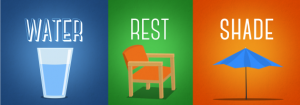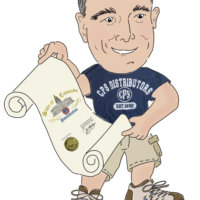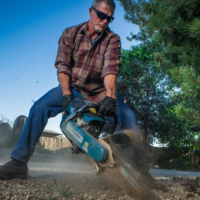 You don’t need us to tell you that temperatures will soon been soaring. While we preach smart irrigation and water efficiency during July in Colorado, one area we certainly don’t want to be efficient with water is the amount of water we put in our bodies. In fact, the U.S. Department of Labor recommends workers drink about one cup of water every 15-20 minutes when working in hot temperatures. Better yet, during prolonged sweating lasting several hours, workers should drink sports beverages containing balanced electrolytes. Also, the high temperatures require significant amounts of rest and shade. Working in such high temperatures can be dangerous for you and your workers. Supervisors and owners need to take responsibility to ensure the health of their workers during the heat.
You don’t need us to tell you that temperatures will soon been soaring. While we preach smart irrigation and water efficiency during July in Colorado, one area we certainly don’t want to be efficient with water is the amount of water we put in our bodies. In fact, the U.S. Department of Labor recommends workers drink about one cup of water every 15-20 minutes when working in hot temperatures. Better yet, during prolonged sweating lasting several hours, workers should drink sports beverages containing balanced electrolytes. Also, the high temperatures require significant amounts of rest and shade. Working in such high temperatures can be dangerous for you and your workers. Supervisors and owners need to take responsibility to ensure the health of their workers during the heat.
Here is an article from the U.S. Department of Labor:
Editor’s Note: This post first appeared on the U.S. Department of Labor website. It was written by Mandy Edens, director of the Occupational Safety and Health Administration’s Directorate of Technical Support and Emergency Management.
 Forecasters are calling for above-average temperatures across much of the country this summer. Are you prepared to beat the heat?
Forecasters are calling for above-average temperatures across much of the country this summer. Are you prepared to beat the heat?
Every year, thousands of workers become ill from working in the heat, and some even die. Construction workers make up about one-third of heat-related worker deaths, but outdoor workers in every industry – particularly agriculture, landscaping, transportation, and oil and gas operations − are at risk when temperatures go up.
Heat-related illnesses and deaths can be prevented. Employers and supervisors can save the lives of workers in hot environments by following these eight simple steps:
-
1. Create a plan
- Institute a heat acclimatization plan and medical monitoring program. Closely supervise new employees for the first 14 days or until they are fully acclimatized. Most heat-related worker deaths occur in the first 3 days on the job and more than a third occur on the very first day. New and temporary workers are disproportionately affected. If someone has not worked in hot weather for at least a week, their body needs time to adjust.
-
2. A cup of water every 15-20 minutes
- Encourage workers to drink about one cup of water every 15-20 minutes. During prolonged sweating lasting several hours, they should drink sports beverages containing balanced electrolytes.
-
3. Provide areas to cool down away from the sun
- Provide shaded or air-conditioned rest areas for cooling down, and empower workers to use them.
-
4. Invest in cooling PPE
- Provide workers with protective equipment and clothing such as water-cooled garments, air-cooled garments, hats, ice-packet vests, wetted over-garments, and heat-reflective aprons or suits.
-
5. Recognize the signs
- Be familiar with heat illness signs and symptoms, and make sure your employees are, too. Some heat exhaustion signs are dizziness, headaches, cramps, sweaty skin, nausea and vomiting, weakness and a fast heartbeat. Heat stroke symptoms include red, hot, dry skin; convulsions; fainting; and confusion. In general, fainting and confusion represent an emergency and should trigger the call for professional evaluation.
-
6. Train employees on the symptoms and plan
- Encourage workers to recognize heat illness symptoms and notify a supervisor or medical professional if they or other coworkers are showing signs. Implement a buddy system where workers observe each other for early signs and symptoms of heat intolerance.
-
7. There’s an app for that
- Download OSHA’s Heat Safety Tool on your iPhone or Android device to help calculate the heat index, a measurement of how it feels when considering humidity. The app provides specific recommendations for preventing heat illness based on the estimated risk level where you are working. Check it out here.
-
8. What to do in an emergency
- Know what to do in an emergency. Employees should call a supervisor for help. If a supervisor is not available, call 911. Have someone stay with the worker until help arrives.
More resources are available on OSHA’s website in English and Spanish. Remember: “Water. Rest. Shade.” can prevent heat illness and save lives.







